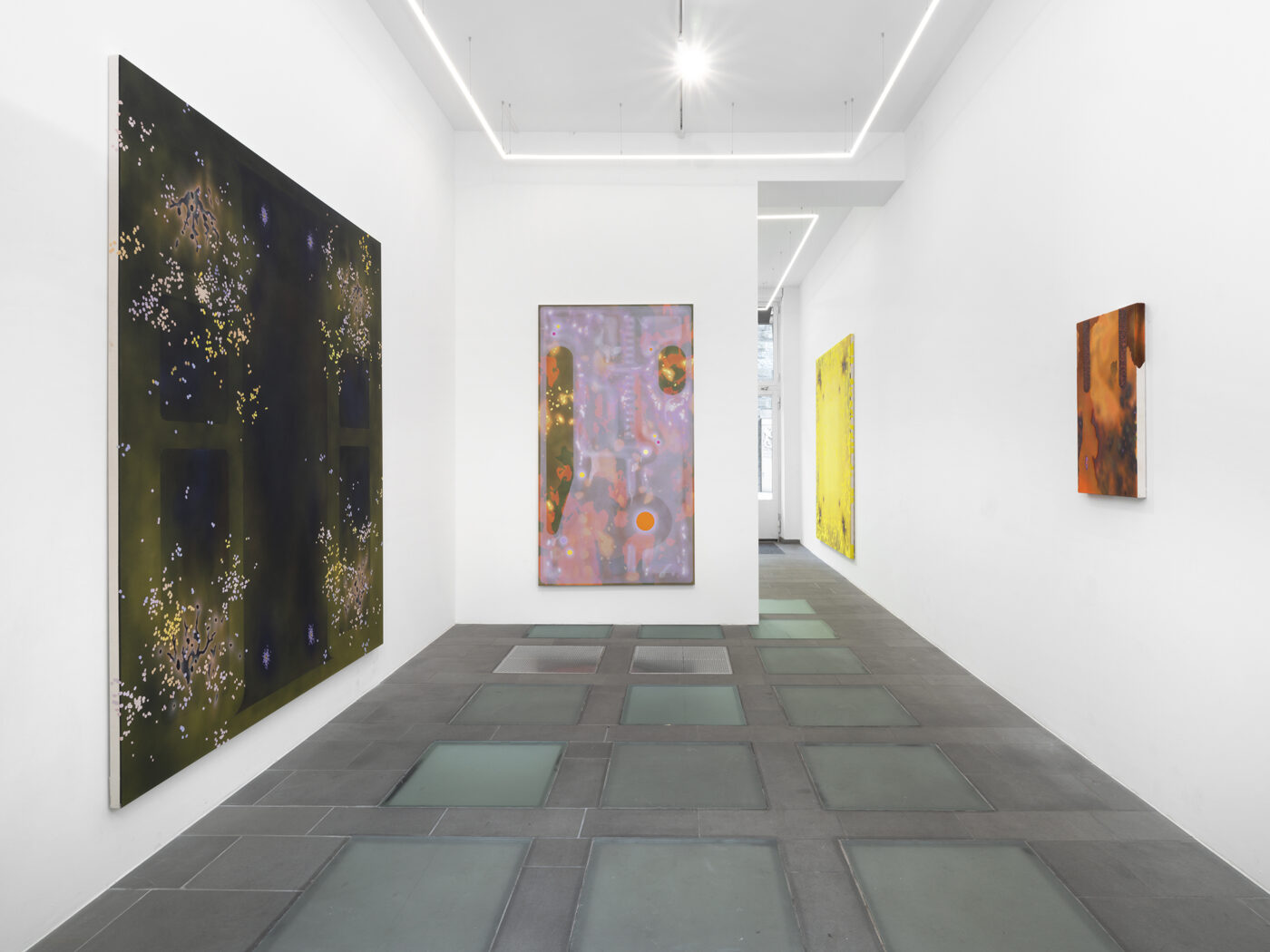Natacha Donzé: Predictive Meadows 13 May—18 June 2022
Views

|

|

|

|

|

|

|

|

|

|
acrylic and flock on canvas, 210 x 190 cm

|
acrylic on canvas, 220 x 120 cm

|
acrylic and flock on canvas, 70 x 40 cm

|
acrylic and flock on canvas, 220 x 190 cm

|
acrylic on canvas, 220 x 190 cm
-
Exhibition view
-
Exhibition view
-
Exhibition view
-
Exhibition view
-
Exhibition view
-
Exhibition view
Text
It is difficult to recognize the weapon in this white plastic object with schematic shapes. Yet there is a slightly serrated handle, a hole large enough for a finger to grasp the trigger, a few screws and a small cylinder as a barrel. In the United States, so-called “ghost guns” are proliferating: delivered in kit form or 3D printed from files that can be downloaded online, they have no serial number and are untraceable. Before becoming potentially lethal objects, they circulate in the form of images – a two-dimensional manufacturing plan whose geometric edges, sometimes crenellated, or rounded gaps allow us to envisage its future use.
It is this image of a flat ghost weapon that Natacha Donzé has affixed – like a cover – on the three canvases that compose the Ghost Guns series. It is this image of a flat ghost weapon that Natacha Donzé has affixed – like a cover – on the three canvases that compose the Ghost Guns series. Of an iridescent transparency, it reveals a set of underlying motifs in fluorescent orange, khaki, yellow and glaucous green. They make up images that are always different: a brackish lake where tadpoles[1] are swarming, unless
It is difficult to recognize the weapon in this white plastic object with schematic shapes. Yet there is a slightly serrated handle, a hole large enough for a finger to grasp the trigger, a few screws and a small cylinder as a barrel. In the United States, so-called “ghost guns” are proliferating: delivered in kit form or 3D printed from files that can be downloaded online, they have no serial number and are untraceable. Before becoming potentially lethal objects, they circulate in the form of images – a two-dimensional manufacturing plan whose geometric edges, sometimes crenellated, or rounded gaps allow us to envisage its future use.
It is this image of a flat ghost weapon that Natacha Donzé has affixed – like a cover – on the three canvases that compose the Ghost Guns series. It is this image of a flat ghost weapon that Natacha Donzé has affixed – like a cover – on the three canvases that compose the Ghost Guns series. Of an iridescent transparency, it reveals a set of underlying motifs in fluorescent orange, khaki, yellow and glaucous green. They make up images that are always different: a brackish lake where tadpoles[1] are swarming, unless they are cells observed under a microscope (Ghost Gun I); cartographies of demographic indices or the propagation of a virus (Ghost Gun II); landscapes on fire seen from the sky (Ghost Gun III). Each time, the fine gradations of color, the forms surrounded by halos give the images an almost thermal relief. Whatever the scale – micro or macroscopic – suggested, these environments or topographies evoke lives in development; those larval of the tadpoles, and those, which have become data, whose flows are objectified. These bodiless existences grow, fixed under the transparent glaze of the phantom weapon. Paradoxically, we can only observe them through the index of their potential annihilation. Contained in an ectoplasmic membrane, these images seem promised to a life without incarnation, passing directly from the state of embryo to that of ghost. A fate, that of the digital images, that painting can materialize.
Just as the milky surface seems to protect or preserve the underlying rhizomic life in the Ghost Guns series, Do You Love Me? is presented in an acid yellow relief speckle. The picture of a parallelepiped radiating in the middle of a faded yellow field has been evenly flocked with fluffy islands, like a pollen explosion. The resistance of this marking technique (used in the textile or automotive industries) and its pigmentation – more fluorescent than the fluorescence to which paint could lay claim – makes it a canvas above the means of painting, almost rid of its material and chromatic finality. No wonder then that the yellow and black colors were inspired to Natacha Donzé by an android robot which, under the shape of a dog, tends to compensate for the physical and cerebral human limits.
Where human flows are optimized, weapons dematerialized and relationships robotized, fauna and flora remain a reference in terms of representation. The figure of the dog will probably allow households to better domesticate robotics, just as the image of pollination values exchanges, whether they be romantic, financial or managerial. Natacha Donzé’s “meadow” is in the flatness, tributary of Mark Rothko[2]‘s abstract color fields as much as it is electric and buzzing, in the dissemination of signs and their permanent recomposition.
So this meadow does not predict anything that we cannot already observe: the impossible flowering in the digital age of stillborn images on which the promise of transparency casts an opaque veil. This does not prevent them – in the gaps – from sparkling.
Elsa Vettier
[1] Tadpoles that succeed here to the small eggs that were often found nested in previous series of the artist
[2] Mark Rothko is one of the artists generally associated with “color field painting” – a subcategory of Abstract Expressionism – which is characterized by the flattening of raw colors over large areas of the canvas.
